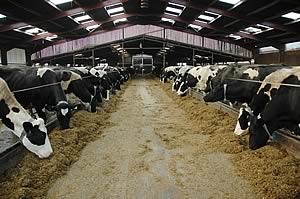02/09/08
Specialist feed company SCA NuTec is incorporating new advanced fertility and nutrition technology into a fertility programme to be unveiled this autumn.
This programme consists of consecutive feeding two products each with a specific composition of omega-6 and omega-3 fatty acids. It has been shown to boost dairy cow fertility significantly and result in more successful pregnancies, as well as raise milk yields.
“Omega-3 and 6 fatty acids are attracting a lot of attention in human nutrition and there is growing evidence that these fatty acids also have beneficial effects on dairy cow health, particularly on the production of prostaglandin in the uterus,” says company ruminant nutritionist Norman Downey.
Through SCA’s global research programme - run by parent company Provimi – the research on omega fatty acids and subsequent trial work has led to the development of two important new feed additives - Strata-G Dry Period and Strata-G Lactation that can be used in total mixed rations or compound feeds.
Strata-G Dry Period is high in linoleic acid, an omega-6 fatty acid that stimulates prostaglandin production, the hormone that promotes contraction of the uterus, which is important around calving.
Strata-G Lactation is rich in omega-3 fatty acids sourced from fish oil. Its role is to reduce prostaglandin production. It plays an important part in embryo implantation by preventing embryonic loss.
“The role of fish oil is important here as it has a larger effect on regulating prostaglandin production than omega-3 fatty acids from linseed,” adds Mr Downey. “We’ve been able to take the use of omega-3 fatty acids, as well as omega-6 fatty acids, a step forward and overcome their effect on rumen microbes that leads to depressed milk fat and feed intakes. This has been possible by using patented technology that produces rumen inert omega-fatty acids from fish oil. Strata G Dry Period and Lactation therefore pass into the small intestine and can be absorbed and used in the right place for the right job.”
The Strata-G Fertility Programme has been used successfully in trials. In one large-scale university-performed project with more than 500 cows, the group fed on the Strata-G feeds showed an improvement of 60-day pregnancy rates of 15%. This same group also recorded milk yields of 1kg higher than the control group. This level of improvement in fertility is estimated to improve margins by £2400 in a typical 100-cow herd.
Both feeds are recommended for feeding as part of total mixed rations - available in 25kg bags - or in compound feed at a rate of 115g/head/day. Strata-G Dry Period is recommended for three weeks pre calving followed by Strata-G Lactation for the first four to six months of lactation.
 New Dairy Feed Range Can Cut Costs But ‘Max’ On Milk New Dairy Feed Range Can Cut Costs But ‘Max’ On Milk
 Milk from Grass Booster Approved for Organic Milk from Grass Booster Approved for Organic
 Pasture Improvement Offers Valuable Extra Returns Pasture Improvement Offers Valuable Extra Returns |



